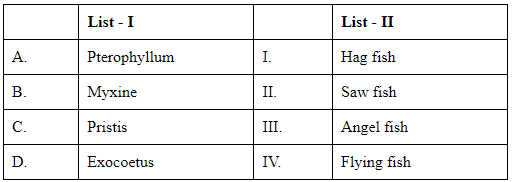31 Years NEET Previous Year Questions: Animal Kingdom - 1 - NEET MCQ
24 Questions MCQ Test - 31 Years NEET Previous Year Questions: Animal Kingdom - 1
Match List I with List II: (NEET 2024)

Choose the correct answer from the options given below :

Consider the following statements : (NEET 2024)
A. Annelids are true coelomates
B. Poriferans are pseudocoelomates
C. Aschelminthes are acoelomates
D. Platyhelminthes are pseudocoelomates
Choose the correct answer from the options given below :
A. Annelids are true coelomates
B. Poriferans are pseudocoelomates
C. Aschelminthes are acoelomates
D. Platyhelminthes are pseudocoelomates
The following are the statements about non-chordates: (NEET 2024)
A. Pharynx is perforated by gill slits.
B. Notochord is absent.
C. Central nervous system is dorsal.
D. Heart is dorsal if present.
E. Post anal tail is absent.Choose the most appropriate answer from the options given below:
B. Notochord is absent.
C. Central nervous system is dorsal.
D. Heart is dorsal if present.
E. Post anal tail is absent.Choose the most appropriate answer from the options given below:
Match List I with List II : (NEET 2024)

Choose the correct answer from the options given below :
Radial symmetry is NOT found in adults of phylum ______. (NEET 2023)
The unique mammalian characteristics are: (NEET 2023)
Select the correct statements with reference to chordates. (NEET 2023)
A. Presence of a mid-dorsal, solid and double nerve cord.
B. Presence of closed circulatory system.
C. Presence of paired pharyngeal gill slits.
D. Presence of dorsal heart
E. Triploblastic pseudocoelomate animals.
Choose the correct answer from the options given below:
Exoskeleton of arthropods is composed of: (NEET 2022 Phase 1)
Given below are two statements: one is labelled as Assertion and the other is labelled as Reason. (NEET 2022 Phase 1)
Assertion: All vertebrates are chordates, but all chordates are not vertebrates.
Reason: Notochord is replaced by a vertebral column in the adult vertebrates.
In the light of the above statements, choose the most appropriate answer from the options given below:
Which of the following animals has three chambered heart? (NEET 2022 Phase 2)
Select the incorrect statements with respect to Cyclostomes: (NEET 2022 Phase 2)
(a) They lack scales and paired fins.
(b) They have circular mouth with jaws.
(c) They bear 6-15 pairs of gills.
(d) They migrate to deep sea for spawning.
Choose the most appropriate answer from the options given below:
Read the following statements. (NEET 2021)
(a) Metagenesis is observed in Helminths.
(b) Echinoderms are triploblastic and coelomate animals.
(c) Round worms have organ-system level of body organization
(d) Comb plates present in ctenophores help in digestion.
(e) Water vascular system is characteristic of Echinoderms.
Choose the correct answer from the options given below.
Bilaterally symmetrical and acoelomate animals are exemplified by : [NEET 2020]
Consider the following features. [NEET 2019]
(A) Organ system level of organisation
(B) Bilateral symmetry
(C) True coelomates with segmentation of body
Select the correct option of animal groups which possess all the above characteristics.
Which one of the following characteristics is not shared by birds and mammals ? [2016]
Which of the following characteristic feature always holds true for the corresponding group of animals? [2016]
Body having meshwork of cell, internal cavities lined with food filtering flagellated cells and indirect development are the characteristics of phylum ______. [2015 RS]
A jawless fish, which lays eggs in fresh water and whose ammocoetes larvae after metamorphosis return to the ocean is: [2015 RS]
Which of the following animals is not viviparous? [2015 RS]
Select the Taxon mentioned that represents both marine and freshwater species: [2014]
Planaria possesses high capacity of: [2014]
A marine cartilaginous fish that can produce electric current is: [2014]
Which of the following represents the correct combination without any exception?

Which of the following features is not present in the phylum - Arthropoda?


















